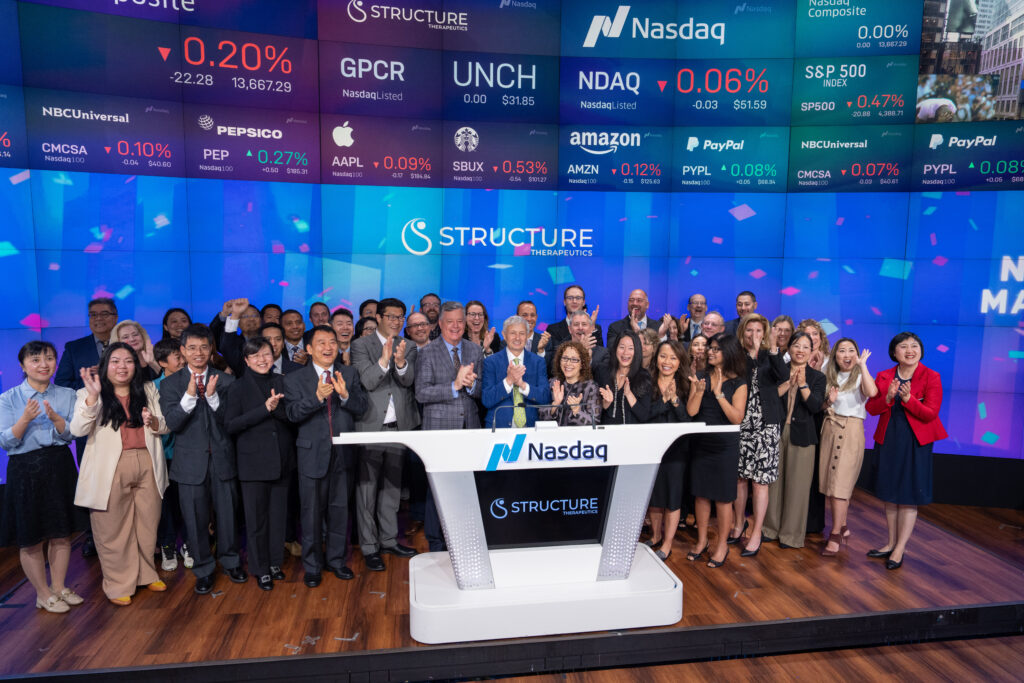Biologics and peptides have revolutionized healthcare setting the stage for a new generation of equally transformative orally available small molecule medicines.
Structure Therapeutics
- Leadership
-
Raymond Stevens, Ph.D., Founder and CEO
- Location
- Shanghai, China & San Diego, CA
- Sector
- Therapeutics
- Year Invested
- 2019
- Status
- Public
Providing the next generation of high-impact medicines
A critical gap in understanding GPCR biology has long held back an entire therapeutic category
G-protein coupled receptors (GPCRs) – a family of receptors that sense and respond to external signals – comprise the largest family of targets for approved drugs with 826 identified members, which represents approximately 475 drugs on the market acting on over 100 unique GPCRs. Abnormal GPCR activity has been directly linked to various chronic diseases including cardiovascular, metabolic, and pulmonary conditions. Despite the wealth of commercialized compounds, these proteins remain one of the most challenging target classes for structure-based drug discovery because advances in our overall knowledge of receptor structure and function have been relatively slow. As a result, more than 220 GPCRs have not yet been explored as clinical targets.
“Because the structure and function of biological macromolecules (i.e., proteins) are intimately intertwined, structural biology-based approaches offer an important foundation for drug discovery,” said Raymond Stevens, Ph.D., Founder and CEO of Structure Therapeutics. “Researchers have long sought out structural insights to gain intel about some of the most challenging targets (including GPCRs) across disease indications, and F-Prime shares in our commitment to developing differentiated small molecule therapies to overcome the limitations of biologics and peptide therapies and provide better treatment options for patients everywhere.”
Small molecules are a category of medicine that offers substantial benefits such as their oral administration and design, which optimizes and targets distribution in the body. In addition, their potential for patient compliance is higher and they offer more flexibility than biologics.
One small discovery could pave the way to one large leap in medicine
Structure Therapeutics’ story began several years ago, when Professor Raymond Stevens’ research group at Scripps Research saw an opportunity to dive deeper into the science of GPCRs and the team’s foundational work was the successful initial reveal of the first human GPCR crystal structure bound to a diffusible ligand. This important discovery was followed by the characterization of other human GPCRs and coincided with over two decades of innovation in generating membrane protein structures with a focus on GPCRs to establish Structure Therapeutics.
While Structure can use its technology to develop drugs across a wide variety of GPCR targets, its initial programs focus on clinically validated targets to minimize biological risks. In addition, Structure believes that by offering small molecule drugs against targets where there are biologics administered as an injection, one can offer patients a more convenient alternative for much-needed medicines that can be dosed orally and cost less.
In only a few years from its founding in 2016, Structure Therapeutics successfully advanced two small molecule programs into clinical trials (GSBR-1290 and ANPA-0073) and one more in IND-enabling studies (LTSE-2578). The company raised $198 million privately before becoming one of biotech’s first initial public offerings in 2023. In addition, their lead program, the oral small molecule GLP-1 selective receptor agonist, has the potential to revolutionize the multiple billion-dollar obesity and diabetes market that is currently dominated by injectable and oral peptide drugs. F-Prime and Eight Roads had the foresight to know that GLP-1 was an increasingly important drug class.
The Structure Solution: Built for speed and efficiency
At the end of September, Structure announced positive results from the Phase 1b multiple ascending dose (MAD) study of its highly selective oral GLP-1 receptor agonist, GSBR-1290, in healthy overweight, or obese individuals. In the 28-day study, GSBR-1290 demonstrated significant weight loss supporting once-daily (QD) dosing and an encouraging safety and tolerability profile.

F-Prime acts locally to have an impact globally
At F-Prime, we help advance entirely novel technology platforms and therapeutic modalities by recognizing and furthering scientific breakthroughs. Structure was an attractive investment for F-Prime and Eight Roads from the very beginning and underscores how small molecule drug design is being transformed thanks to the explosion of cryo-EM and advances in computational chemistry.
The company created a global footprint early on, instituting its headquarters with business operations, finance, and clinical development in South San Francisco, and discovery and preclinical operations in Shanghai. This allowed the company to leverage the talent, resources, and infrastructure e.g., CROs available on both sides of the ocean. Working together with a global mindset, F-Prime’s Partners, Robert Weisskoff and Chong Xu helped to further guide the building of the company. Structure started with hiring, where F-Prime, together with Eight Roads, was key to recruiting their initial drug discovery and preclinical development leaders. The skilled group of drug developers, industry leaders, and scientific experts brought deep experience in understanding complex biological targets and mechanisms and had previously led the discovery, development, and commercialization of multiple successful drugs. The early discovery and preclinical efforts originally began in Shanghai and then followed in the U.S. with clinical activities as the company expanded its global operations. In addition, they facilitated the company’s business and financing – ultimately preparing the company for its public offering.
By empowering the next generation of companies as we did with Structure, we are proactively pioneering breakthrough science, novel technologies, and innovative platforms capable of addressing significant unmet medical needs.
Subscribe to our newsletter to get the latest updates on how our portfolio companies continue to lead the way in their respective fields.
F-Prime shares our commitment to developing differentiated small molecule therapies to overcome the limitations of biologics and peptide therapies and provide better treatment options for patients everywhere.
— Raymond Stevens, Ph.D., Founder and CEO of Structure Therapeutics